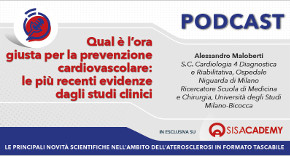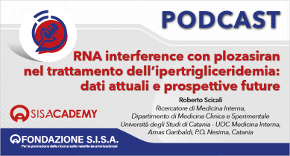 Rivista in lingua italiana
Rivista in lingua italiana
riservata ai Soci SISA
Ultimo numero:
Anno 16 • N.1/2025
Abstract
Vupanorsen, an N-acetyl galactosamine-conjugated antisense drug to ANGPTL3 mRNA, lowers triglycerides and atherogenic lipoproteins in patients with diabetes, hepatic steatosis, and hypertriglyceridaemia
Gaudet D, Karwatowska-Prokopczuk E, Baum SJ, Hurh E, Kingsbury J, Bartlett VJ, Figueroa AL, Piscitelli P, Singleton W, Witztum JL, Geary RS, Tsimikas S, O'Dea LSL; Vupanorsen Study Investigators.
Eur Heart J. 2020;41:3936-3945
Aims: Loss-of-function mutations in ANGPTL3 are associated with beneficial effects on lipid and glucose metabolism and reduced risk of coronary artery disease. Vupanorsen (AKCEA-ANGPTL3-L Rx ) is an N-acetyl galactosamine-conjugated antisense oligonucleotide targeted to the liver that selectively inhibits angiopoietin-like 3 (ANGPTL3) protein synthesis.
Methods and results: This was a double-blind, placebo-controlled, dose-ranging, Phase 2 study. Patients (N =105) with fasting triglycerides >150 mg/dL (>1.7 mmol/L), type 2 diabetes, and hepatic steatosis were treated for 6 months with 40 or 80 mg every 4 weeks (Q4W), or 20 mg every week (QW) of vupanorsen, or placebo given subcutaneously. The primary efficacy endpoint was per cent change in fasting triglycerides from baseline at 6 months. Median baseline triglycerides were 2.84 mmol/L (252 mg/dL). Significant reductions in triglycerides of 36%, 53%, 47%, and in ANGPTL3 of 41%, 59%, 56%, were observed in the 40 mg Q4W, 80 mg Q4W, and 20 mg QW groups, respectively, compared with 16% reduction in triglycerides and 8% increase in ANGPTL3 in placebo. Compared with placebo, vupanorsen 80 mg Q4W reduced apolipoprotein C-III (58%), remnant cholesterol (38%), total cholesterol (19%), non-high-density lipoprotein cholesterol (HDL-C; 18%), HDL-C (24%), and apolipoprotein B (9%). There was no improvement in glycaemic parameters, or hepatic fat fraction. Treatment with vupanorsen was not associated with clinically significant changes in platelet counts, and the most common adverse events were those at the injection site, which were generally mild.
Conclusion: Vupanorsen results in a favourable lipid/lipoprotein profile and provides a potential strategy for residual cardiovascular risk reduction.
Keywords: Antisense; Cardiovascular disease; Hypertriglyceridaemia; Vupanorsen; Angiopoietin-like protein 3
Eur Heart J. 2020;41:3936-3945

Area Soci
Eventi
39° Congresso Nazionale
 39° Congresso Nazionale
39° Congresso NazionaleRoma, 23-25 novembre 2025
Save the date




 Spring Meeting Gruppi Giovani SID, SIGG, SIIA, SIMI, SIPREC, SISA
Spring Meeting Gruppi Giovani SID, SIGG, SIIA, SIMI, SIPREC, SISARimini, 6-8 aprile 2025
[continua a leggere]
 SISA LIPID ACADEMY - Corso avanzato di lipidologia clinica
SISA LIPID ACADEMY - Corso avanzato di lipidologia clinicaModena, 4-5 Luglio 2024
[continua a leggere]Giornale Italiano Arteriosclerosi
HoFH today
 Rivista Italiana della
Rivista Italiana della
Ipercolesterolemia
Familiare Omozigote
Anno 6 • N.1/2024
Rivista NMCD
Diateca
[continua a leggere]
[continua a leggere]
Newsletter
il vostro indirizzo di posta elettronica
Progetto LIPIGEN

Nuovo sito dedicato al Progetto LIPIGEN
Progetto LIPIGEN - Vecchio portale
E' necessario essere loggati come utente
Lipigen per poter accedere alla pagina
PROject Statin Intolerance SISA
PROSISA – PROject Statin Intolerance SISA
E' necessario essere loggati come utente
PROSISA per poter accedere alla pagina
GILA - Lipoprotein Aferesi
Gruppo Interdisciplinare Lipoprotein Aferesi
(Accesso Gruppo GILA-Lipoprotein Aferesi)
E' necessario essere loggati come utente del Gruppo GILA per poter accedere
Gruppo Interdisciplinare Lipoprotein Aferesi
(Documentazione ad accesso libero)
Pagina informativa per medici e pazienti










